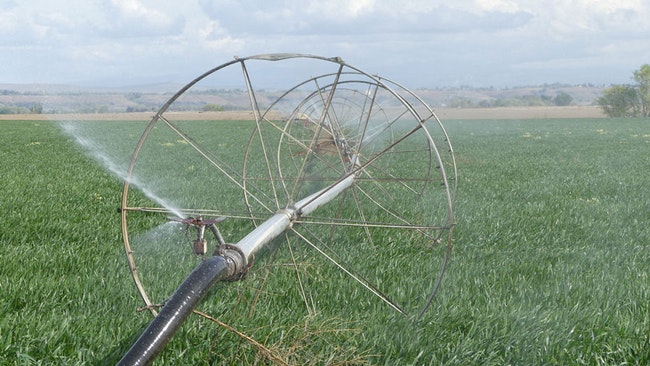
Fewer winter storms and meager run off means area farmers will face a new challenge through the planting season. (The Enterprise/File).
NYSSA – Mother Nature wasn’t as generous this year as in the past with snowpack levels and her fickle nature will impact Malheur County’s agriculture industry.
Area water managers are already beginning to tighten water allocations.
“The inflows are looking as bad as they did in ’14 and ’15,” said Jay Chamberlin, manager of the Owyhee Irrigation District.
Chamberlin was referring to years when drought clutched most of the area and forced local irrigation districts to ration water.
Malheur County’s agriculture economy depends on a sometimes-erratic template of snowpack and snow runoff to fill the local reservoirs. Those reservoirs then serve area farmers and ranchers through planting and harvest seasons.
During the last few years, water availability wasn’t a major problem but this year the game has changed as fewer winter storms left behind barely adequate snowpack in the mountains that surround the Malheur and Owyhee Basins.
As of April 23, only one area reservoir – Bully Creek, nine miles west of Vale – was nearly full at 92%.
Beulah reservoir was 65% full as of Friday while Warm Springs reservoir stood at 47% full. The Owyhee Reservoir was 59% full Friday.
“We’ve been in the midst of warm weather and it accelerated the snow melt run-off rate which, obviously, is a concern because if you have a higher rate of runoff you have less available in surface water supply in the summer months,” said Scott Oviatt, snow survey supervisory hydrologist for the National Resources Conservation Service.
The April water basin outlook from his agency showed near or above normal snowpack for most of Oregon with “persistent, below-normal snowpack in southwest and southeast Oregon.”
“Streamflow volumes across southern Oregon remain well below normal, with several streams below 50%,” the conservation service reported showed.
Oviatt said the Owyhee Basin snow pack was 53% of average while the Malheur Basin snowpack was 40% of average.
“It isn’t what we want to see,” said Oviat.
The Owyhee Irrigation District already slashed its water allocation from 4 feet to 3 feet for the year, meaning farmers can count on receiving less water through the season.
“We will watch and see and if it looks a little different in the mid-summer we will bump it up,” said Chamberlin.
Farmer Bruce Corn said there is already consistent, earlier-than-usual use of the Owyhee Reservoir’s water.
“More is coming out for irrigation needs than is going in,” said Corn.
Corn, who serves on the Owyhee Irrigation District Board, said the area isn’t “off to a good start.”
“We really haven’t had significant rains. So, yeah, it is a concern. At the end of the year reservoirs in this area could be depleted to zero or near zero,” said Corn.
Corn said he believes there will be enough water to go around this year but demand is high now “because the wind dried out the ground.”
Corn said recent water conservation innovations such as drip and sprinkler irrigation will help farmers.
“They use significantly less water than siphon tubes. So, all of these conservation things have really been beneficial,” said Corn.
Stuart Reitz, the director of the Oregon State University Malheur Experiment Station, said the upcoming water year will be “tight, but manageable.” Yearly fluctuations of irrigation water supply are normal, he said.
“If you look historically, there are better years than others and it is not nearly as bad as five or six years ago when it went down to one foot,” said Reitz.
Corn said he remembers five and six years ago the water allotment dropped because of drought.
“Every year stands on its own but, obviously, we will do everything we can to conserve,” said Corn.
News tip? Contact reporter Pat Caldwell at [email protected]
Low reservoir levels in Malheur County signal dismal irrigation season
Late winter storms boost area snowpack levels
SAFEGUARD YOUR LOCAL NEWS
Take one action today to help the Enterprise grow and do more for the community through accurate, fair reporting.
SUBSCRIBE: A monthly digital subscription is $5 a month.
GIFT: Give someone you know a subscription.
ONE-TIME PAYMENT: Contribute, knowing your support goes towards more local journalism you can trust.




